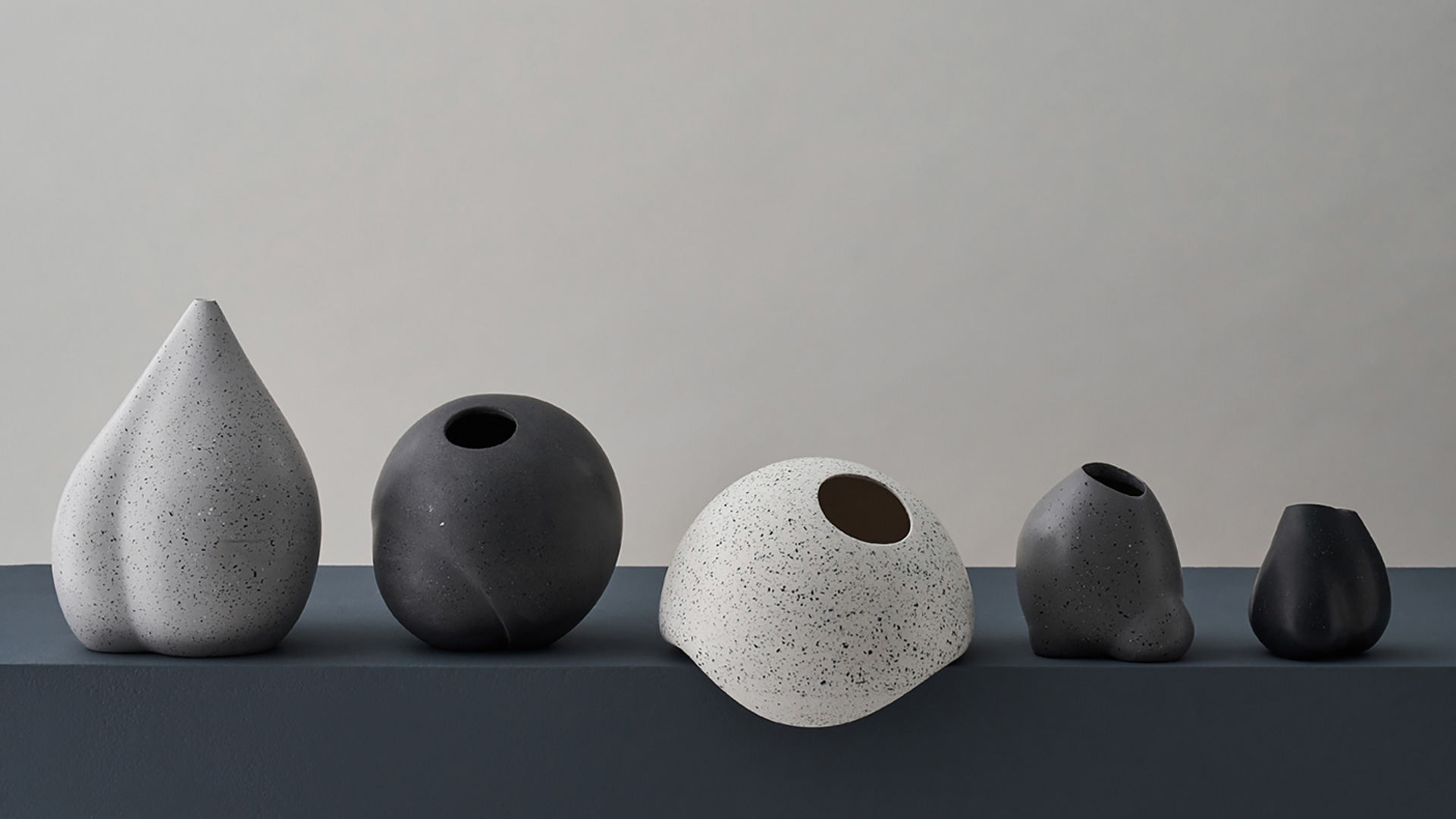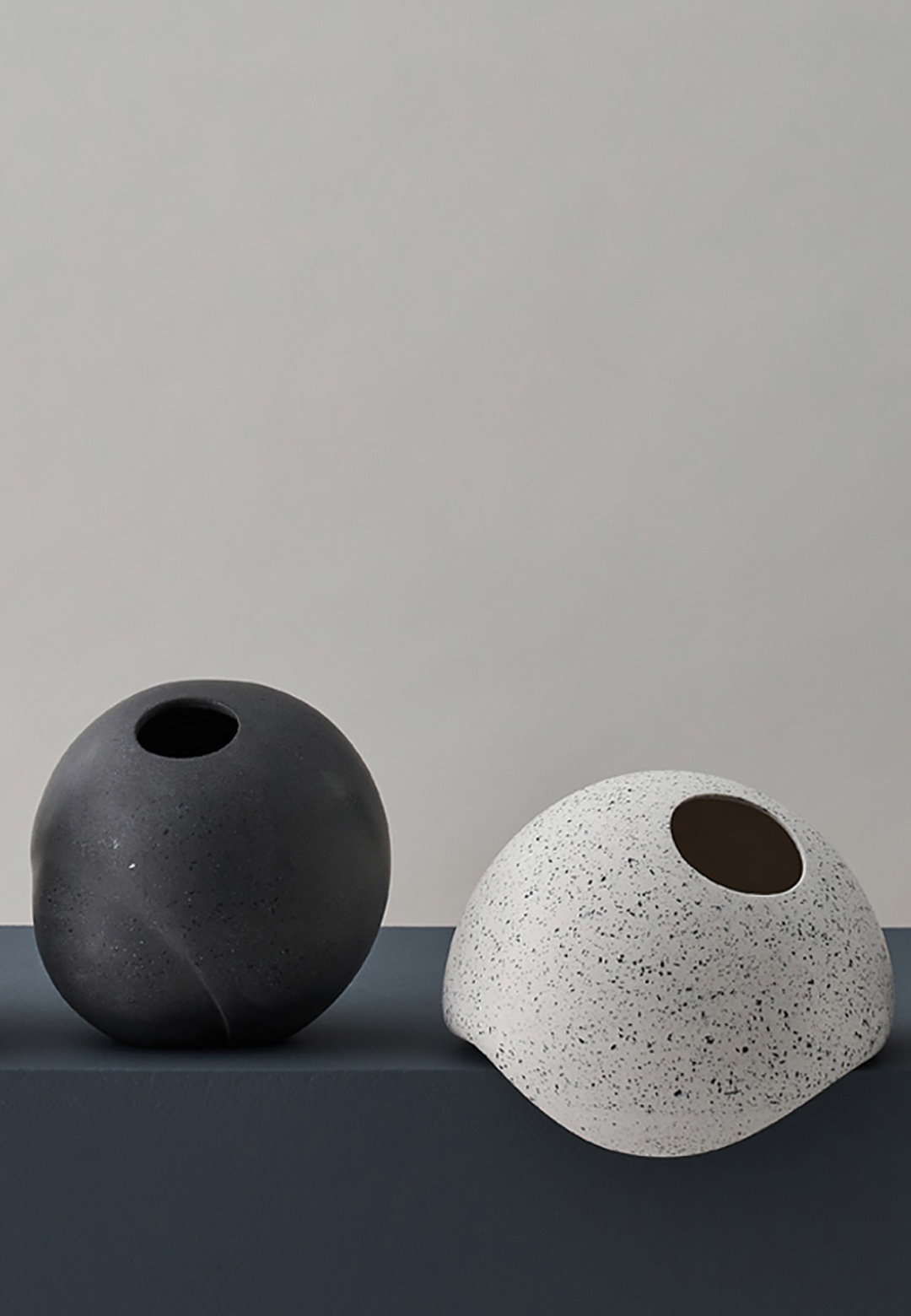Spared by Volume Creative
Volume Creative a design agency based in Sussex, United Kingdom has taken an initiative towards turning waste into bespoke furniture and objects by launching ‘Spared’, showcasing a series of achromatic vessels to represent signs of coral degradation through various shades of black and white crafted using finely ground-down black post-consumer plastic waste. The materials offered belong to the terrazzo family, created using recycled plastics and shells, called Plarix and Molelk. A project that grew out of years and research and development as a desire to reduce and reuse waste from the design industry set at the vanguard of creative interior design objects in harmony with environmental sensitivity.
Chitofoam by Doppelgänger
Doppelgänger an American design studio driven by Charlotte Böhning and Mary Lempres has addressed this issue through a blend of science and technology manifested in their recent material innovation ‘Chitofoam’. Exoskeletons of styrofoam-eating meal worms have been used to make this bioplastic material analogous to polystyrene foam. Chitofoam can be moulded into cups as well as different forms of packaging owing to its impressive versatility, water resistance, and shock absorbance, as well as its ability to decompose easily, unlike the very plastic it is devised to replace. Chitofoam is a circular design solution for Styrofoam waste management in order to cater to the entire lifecycle of the object. Although in its initial stages, this innovation has contributed magnanimously to the start of sustainable material alternatives.
Polyformer by Reiten Cheng
“Reshape, Recreate and Reproduce” is the motto behind a unique product called ‘Polyformer’ devised by industrial designer Reiten Cheng is a contribution to 3D printing with the thought of eradicating the plastic crisis, specifically focusing on plastic PET bottles. Polyformer is essentially a 3D-printed, compact, uncomplicated, and one-of-a-kind machine that recycles PET bottles into filaments for other 3D printers to use employing an easy-to-follow process. Every prototype printed brings this ongoing project one step closer to driving a 3D printing evolution that the world has yet to witness. Until then, any 3D printer user or designer can simply make his or her own iterations and changes to the design for his or her own convenience and comfort, while keeping the environment in mind.
Material Consciousness by Brodie Neill
A creative sustainable design idea by Australian designer Brodie Neill to envision objects out of ocean waste gave rise to this furniture collection touted ‘Material Consciousness’ comprising nine pieces that deliver an important message of sustainable practices representing the convergence of design research, material circularity and redefining of waste. Neill focuses on utilising ocean plastic to create usable products and objects which led him to create an innovative material called ‘Ocean Terrazo’ out of plastic decanted from oceans that have been used to craft pieces like the Gyro second wave, Jetsam, and Flotsam by Neill enunciates the power of innovative designs created using recycled materials.
RCP2 Chairs by Jane Atfield
Emma Scully Gallery's latest exhibition showcased British furniture designer Jane Atfields RCP2 Chairs as a way of celebrating design that encourages the recycling of plastic waste into useful objects. The evocative and colourful materiality of the chairs speaks volumes about the meaning behind Jane’s statement about consumer culture and climate change. A striking feature of the chairs is their history of being the first furniture pieces exclusively made out of recycled plastic in 1992 using recycled materials made by Yemm and Hart. The material was recycled from the plastic wastes of shampoo and detergent bottles into high-density polyethene plastic sheets. This collection comes in three colour variants of RCP2 chairs and a unique table stands as an inspiration for contemporary designers of today.
Lua Lamp by Dezero Estudio
Spanish studio Dezero Estudio crafted the Lua Lamp which at first glance appears to be an animated character straight out of a cartoon show. This lamp design incorporates a handle and cap that appear like a helmet and the circular luminaire with the holder at the bottom resembles the face and body of a cartoon character. The studio’s focus on sustainability drove them towards using recycled plastic from PET bottles and plastic caps as the major material for Lua Child, making up the body and helmet of the lamp while the handle, buttons, and dial are made out of soft silicone which is both ecological, hygienic and soft. The Lua Nature lamp on the other hand has a blend of coconut fibres and recycled plastic, while the handle, made of oak makes for a sturdy grip and warm appearance. Each Lua Lamp contains 85% recycled plastic, making it the ideal example of abstract meets sustainable lighting design.
Flaming Stars by Natascha Madeiski
Flaming stars is a series of table lamps designed by UK-based multidisciplinary designer Natasha Madeiski for German luxury furniture brand pulpo, based on the belief that waste discards, broken glass pieces, dilapidated surfaces, and worn-down clothes can sometimes make for good raw materials. The seven lamps showcased in this collection utilise the likes of home-baked bread, a modelling balloon, a plastic funnel, off-cut materials, and other miscellaneous domestic objects. Flaming stars is a lamp design that can be mass-produced while still preserving its uniqueness and individuality.
Foamy by Balance is Motion
Balance in Motion (BiM) designed a small yet impactful collection Foamy, furniture for indoor public spaces such as libraries and hospitals, envisioning it as a reincarnation of the waste foam material Polimix, specifically from the local Czech manufacturer Yate. Foamy chair design is crafted by incorporating segments of foam held together by metal frames. Using this modular system enabled the team to bypass the limitations of the recycling process. BiM collaborated with a local company called Plastic Guys to procure recycled plastic boards from which the base and side panels are realised.
Great Mate by Great Wrap
Julia and Jordy Kay, CEOs, and co-founders of the Melbourne-based biomaterials company Great Wrap devised a product design called ‘Great Mate’ as the dispenser for their existing sustainable alternative to petroleum-based cling wrap, Great wrap. Designed to clothe the cling wrap, Great Mate is a refillable dispenser made from 33 recycled PET bottles derived as an extension of the company’s sustainable approach, manufactured by a team of engineers and industrial designers at Bayly Group. Great Mate’s ergonomic design is a culmination of sustainability and design language providing it with functionality, reduced impact on waste systems, and growth toward a market of reusable, refillable, and recycled products. An ideal example of kinship between salvaged waste and sustainable alternatives, Great Mate is a beacon of hope for the future of sustainable design.
Eindhoven Project by Lauren Goodman
Eindhoven Project is named after the city where Goodman the exploration for material waste. A third iteration of her experiments in place-based design makes it an integral component of a larger body of work that uses local waste, from dilapidated bicycles from river bodies to metal waste from the city’s scrap bins and utilised steel, bronze, discarded oil barrels, ironing boards, and scrap steel reimagined into design objects. Goodman’s desire to create from what already exists is consciously driven by the use of salvaged bits and pieces of metal and plastic patched together to craft tangible and functional objects. Viewing trash as a material resource draws attention to a local waste and changes the perspective of ‘This trash is someone else's problem’ which is Goodman’s ongoing project showcasing Eindhoven Project.
Sustainability embedded into new-age product innovations is the optimum solution to combat the hazardous influence of single-use plastics promoting climate change. Contemporary designers and artists have initiated a surge of product designs that stand as an inspiration to what the world needs NEXT, making it better for the ecosystem.
Text by Ria Jha






 Sign in with email
Sign in with email










What do you think?